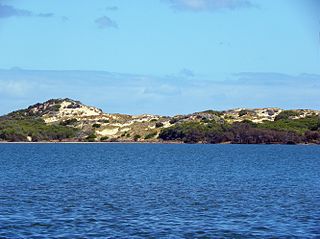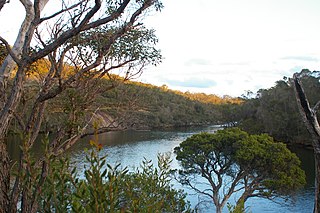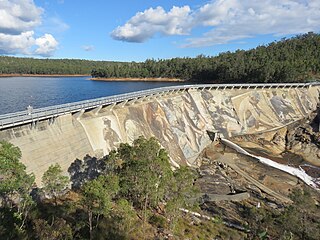
Collie is a town in the South West region of Western Australia, 213 kilometres (132 mi) south of the state capital, Perth, and 59 kilometres (37 mi) inland from the regional city and port of Bunbury. It is near the junction of the Collie and Harris Rivers, in the middle of dense jarrah forest and the only coalfields in Western Australia. At the 2021 census, Collie had a population of 7,599.

The Blackwood River is a major river and catchment in the South West of Western Australia.

Wellington Dam Hydro Power Station is a hydroelectric power station near Collie, Western Australia. It has one water turbine with a generating capacity of 2 megawatts (2,700 hp) of electricity. The Wellington Dam Hydro Power Station was one of three hydro power stations in Western Australia, with only the Ord River hydro still in operation. The dam was constructed in 1933 and enlarged in 1956, and the power station was built from 1954 to 1956 and commissioned on 3 July 1956. It was placed into care and maintenance in 2007.

The Murray River is a river in the southwest of Western Australia. It played a significant part in the expansion of settlement in the area south of Perth after the arrival of British settlers at the Swan River Colony in 1829.

The Canning Dam and reservoir provide a major fresh water resource for the city of Perth, Western Australia. The dam is situated on the Darling Scarp and is an impoundment of the Canning River. It is noted for its innovative structural and hydraulic design that was considered to be at the forefront of concrete gravity dam design at the time of construction. The Canning Dam was Perth's primary water supply up until the 1960s when other sources of fresh water were tapped. Currently the dam supplies approximately 20 percent of Perth's fresh water. Inflow into the Canning Reservoir is estimated to be 22 gigalitres and has a storage capacity of 90.352 gigalitres.

Leschenault Estuary is an estuarine lagoon that lies to the north of Bunbury, Western Australia. It had in the past met the Indian Ocean at the Leschenault Inlet, but that has been altered by harbour works for Bunbury, and the creation of The Cut north of the historical inlet location.

The Kalgan River is a river in the Great Southern region of Western Australia.

The Capel River is a river in the South West region of Western Australia that rises in the Darling Range east of Mullalyup, and flows into the Indian Ocean at Peppermint Grove Beach.
The Preston River is a river in the South West region of Western Australia.
Brunswick River is a river in the South West region of Western Australia.
The Warren River is a river in the South West region of Western Australia with a catchment encompassing the towns of Manjimup and Pemberton. The river was named by Governor James Stirling, probably after Admiral Sir John Borlase Warren under whom Stirling served whilst in action in North America in 1813.
The Ludlow River is a river in the South West region of Western Australia. It was named after Frank Ludlow, one of the first Western Australian colonists, an arrival on the barque Parmelia in 1829, who explored the locality in 1834.

The Logue Brook Dam is a dam located in the south-west of Western Australia in the Darling Scarp near the town of Yarloop. The impoundment, a reservoir, is known as Lake Brockman.

Lake Kepwari is a man-made reservoir located in the south-west region of Western Australia, about 10 kilometres (6.2 mi) south-east of Collie. "Kepwari" is a Noongar word meaning "playing in water".
The Nambung River is a river in the Wheatbelt region of Western Australia, 170 kilometres (106 mi) north of Perth. The river drains an area between the towns of Cervantes and Badgingarra. In its lower reaches the Nambung River forms a chain of waterholes in the Nambung Wetlands where it disappears underground into a limestone karst system 5.5 kilometres (3 mi) from the Indian Ocean.
The Lunenburgh River is a perennial river in the South West region of Western Australia.

Scott River is a river in the south west of Western Australia, being a tributary to the Blackwood River where it joins just east of Molloy Island. It is partly within the Scott National Park, which is named after the river.
Worsley River is a river in the South West region of Western Australia. The river rises in the Darling Range 2 kilometres (1.2 mi) south of the old timber town of Worsley then flows east and south discharging into the Collie River in Wellington Reservoir.
Lake Carabundup is an ephemeral salt lake located in the Great Southern region of Western Australia, approximately 25 km (16 mi) south west of Cranbrook and 30 km (19 mi) north east of Rocky Gully. It is located in a watershed between the Kent River and Frankland River catchments.

Wellington National Park is a national park in Western Australia, located 10 kilometres (6 mi) west of Collie and approximately 215 km (134 mi) south of Perth in the Shire of Collie along the Coalfields Highway.













